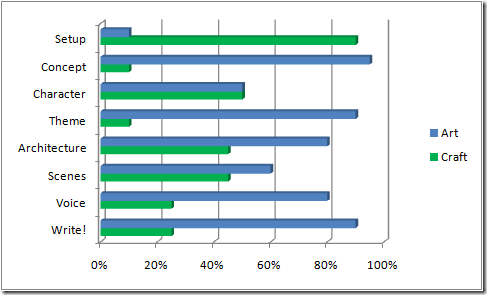Craft
This is the “what you do” of fiction writing or any art form. It’s the hours of practicing scales for a musician, the hours of physical conditioning and practicing free throws for a basketball player. It’s practicing the plays in basketball, practicing double/triple plays in baseball or practicing moving from one song to another in a performance. These are the Basics for a virtuoso in any field.
In fiction writing, it includes Larry Brook’s Six Core Competencies:
- Concept – the idea that evolves into a platform for a story.
- Character – don’t leave home without one.
- Theme – yes, it’s like putting smoke into a bottle, but it can be done.
- Story architecture — what comes first, what comes next, and so forth… and why.
- Scene construction – you can know the game, but if you can’t play it well, you can’t win.
- Writing voice — the coat of paint, or if you prefer, the suit of clothes that delivers it all to the reader.
He says 1 through 4 are elements while 5 and 6 are execution. I’ve got no quibble with that. You need to do all of them pretty darn well to be commercially viable.
Art
Let’s review some of the things we know about art or creativity.
Art is a word which summarizes the quality of communication (L. Ron Hubbard)
The purpose of fiction is to give the audience a powerful emotional experience. (Randy Ingermanson).
It’s not what she said, it’s how she said it.
Ever hear that? It’s the essence of art. It creates an emotion of some sort. It takes imagination and creativity to do it.
So, let’s compare these two ideas:
- Craft is what you do.
- Art/creativity is how you do it.
How good does your Craft have to be to produce art? Technical expertise itself adequate to produce an emotional impact. (L. Ron Hubbard)
How do I tell them apart?
There are two definitions of practice (dictionary.com) which apply:
- The exercise or pursuit of a profession or occupation, esp. law or medicine
- Repeated performance or systematic exercise for the purpose of acquiring skill or proficiency
You can write checklists, lessons and drills about Craft. Many aspects of the Craft can be practiced (repetitions) to a consistent end result.
You can (and should) drill and practice your word processor until it’s so engrained into your eyes and fingers you don’t have to think about it. Same with your keyboard typing. Drill and practice your spreadsheet program (useful for lists, scene organization, etc.). If you do your actual writing in longhand and have a transcriber, drill and practice for optimum speed and legibility. These types of things are the scales, breath control, posture, et. al., of a vocal artist. Drill these basics until they are effortless – require no “think” while you’re doing them.
You can drill and practice all aspects of grammar. Sure, there are variations of spelling, usage, punctuation, sentence structure and the like which purists love to debate, but in the main, grammar is pretty well established. You’ll use your best grammar so your ideas communicate – unless you’re character is being really relaxed and casual. The decision is an artistic decision.
In applying the Six Core Competencies, this is the “pursuit of a profession” practice. You make it a practice to apply them all.
You can’t practice or drill artistic creativity. That’s the great part about it, since you don’t want to be getting the same results each time, do you? There are methods such as mind mapping, brainstorming, what-if sessions which can help you release your creativity, but the results are not fixed. Isn’t that great?
Just remember, "Don't loaf and invite inspiration. Light after it with a club, and if you don't get it you will nonetheless get something that looks remarkably like it." - Jack London
For example, pacing in a scene is necessary. During your designing of that particular scene, you should decide whether it is slow, medium, fast or whatever. Part of that design is artistic in that you decide as an artist where its mission fits within the overall structure. Pacing is fairly straightforward: Slow means you use longer words, longer sentences, longer paragraphs. Fast means you use shorter everything. That’s the What. The How is your word choices, exactly how long to make that dialog before cutting to narrative and how much backstory to insert. You can’t drill that, you need to create the words to convey the desired emotional impact or experience.
The Writing Process
You might wish to review the post on The Process. Here are the main steps again:
- Discover the need
- Gather requirements
- Design
- Write
- Review and approve (edit)
- Publish
- Promote
Just about the time you start gathering requirements, you should do a setup. Create a new directory with any working name. Copy in your template for your overview and beat sheet (we’ll cover this another time). The template ensures you don’t leave something out.
Once you have your template, you can start the Design phase. Yes, you’ll probably tweak the template several times, but if it covers 80% to 90% of what you need for a new project, it will be just fine.
The Design phase covers the Six Core Competencies, sets up your Plot Points, initial hook, characters and everything else you need. You need Design before you can Write.
Even you you are towards the organic/pantsing end, you need some glimmering of Concept, Character or plotting before you start writing. Otherwise, you’ll do a lot of staring at the page "waiting for my muse to tell me what to do.”
The Craft and Art are not mutually exclusive
It is vital to understand this. They are not even on the same scale, that is, as the amount of Craft needed increases, the amount of artistic creativity needed does not decrease. They work together, not in opposition.
Craft and Art are not mutually exclusive, they depend on each other.
Here’s a possible mix:
Nether Craft nor Art are at 0% or 100%. If you’re running at 100% Art, you’re simply daydreaming with no intention/ability of what/how you might communicate any of those miraculous ideas. If you’re running at 100% Craft, it’s your computer program you’ve slaved on to create the “perfect novel”. Neither will sell.
If you’ve done your Needs, Requirements and Design to any decent level, by the time you start the Write!, you can really roll. Notice even in that step, there’s still 25% Craft, but if you’ve done your drilling (typing, writing, etc.) properly, you need extremely little attention on a lot of the mechanics. You know where you’re going, you know the scene’s mission, you know if it’s fast, medium or slow pacing, which characters and all the rest of the Whats. You can let your artistic creativity roll in the How so you can deliver your readers their Powerful Emotional Experiences.
So, leave a comment and tell us if there’s something left out or too much in here.


